January Itinerary in Japan Day 3 (Yamagata Meal edition)
(Thursday, January 27)
Table of contents
1. SUIDEN TERRASSE
I had breakfast at the restaurant of SUIDEN TERRASSE Hotel. Breakfast at SUIDEN TERRASSE is a Japanese buffet with about 30 items. Although it is a buffet, the staff members kindly served me with rice, miso soup, and Dongara-jiru (Chunky cod stew) .
The Japanese buffet at SUIDEN TERRASSE is characterized by offering local ingredients and many local dishes. At the breakfast I had so many local dishes of the Shonai region and Yamagata prefecture. I ate Shonai Asatsuki (spring onion) with vinegar miso, Yamagata prefecture pholiota nameko soy sauce, Shonai beach salt-grilled blackthroat seaperch, simmered Shonai pork, Yamagata specialty Tama konnyaku (ball konjac), Shonai pork sausage, local dish salt natto, soy sauce no mi, Dongara-jiru (Chunky cod stew), Shonai rice (Tsuyahime, Yukiwakamaru), Chokai Kogen yogurt, etc.

Among the foods I ate, “Soy sauce no mi” and “Tama konnyaku” were selected as “Our Regional Cuisines” by the Ministry of Agriculture, Forestry and Fisheries. “Soy sauce no mi” is a versatile seasoning made by mixing soy sauce, wheat, and rice. It seems that they have been eating in the Shonai area since the Edo period. It was a food that goes well with white rice.
“Tama konnyaku” is a local dish that is eaten throughout Yamagata prefecture. “Tama konnyaku” and “Imoni” are the most famous local dish as Yamagata’s food in Japan. It started when the konjac that was brought back from China by the Jikaku Daishi (Ennin) of “Hojusan Risshakuji”, commonly known as “Yamadera” in Yamagata City. “Hojusan Risshakuji” began to be used for the vegetarian cuisine of the temple. “Hojusan Risshakuji” is famous as the place where Matsuo Basho’s “How still it is here–Stinging into the stones, The locusts’ trill.” was written.
At the restaurant, I enjoyed the view of Mt. Chokai and had a good breakfast from the morning.

2. Sengoku-ya
After returning from Mt. Haguro, I ate shio ramen at “Sengoku-ya” for lunch. The owner of “Sengoku-ya” was training at “China Sobaya”, Minoru Sano (deceased person), who is famous in the ramen world. “Sengoku-ya” is about a 5-minute walk from Suiden Terrace.
I ordered the most popular “Shio ramen noodles” (Yen 950). There were char siu, wonton, and soft-boiled egg marinated in soy and mirin on the salt ramen. Especially, the char siu was thick and I liked it.

The taste of shio ramen was not strong, but it was a light type and very delicious. Also, when I came to Tsuruoka, I wanted to visit again.
3. Sushi Koise
I took a taxi from Kamo Aquarium to Uzen-Oyama Station and took a train to Sakata Station. Uzen-Oyama Station is the closest station to Kamo Aquarium. It took about 10 minutes by taxi from Kamo Aquarium to Uzen-Oyama Station, and the fare was about Yen 2,000.
There were no restaurants around Uzen-Oyama Station, but there was a long-established pickle shop “Honcho” that has been in business for over 100 years. Pickles are also one of the important food cultures of Yamagata prefecture. This time it was before dinner so I couldn’t buy pickles. I would like to try the pickles of “Honcho” if I have a chance. You can visit the pickle plant for free at “Honcho”.
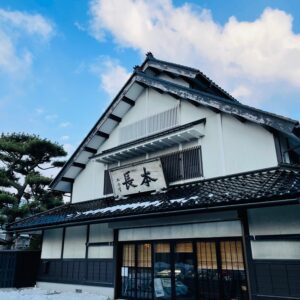
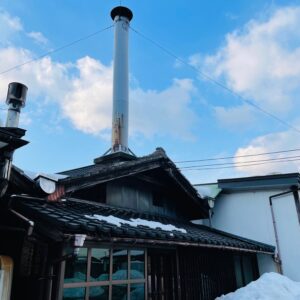

The trains I used from Uzen-Oyama Station to Sakata Station are as follows.
Depart Uzen-Oyama Station at 16:24, Uetsu Line “bound for Sakata”, arrive at Sakata Station at 17:04, fare Yen 590
I went to Sakata station to have dinner at the famous sushi restaurant “Sushi Koise” in the Shonai region. “Sushi Koise” has been selected as one of the 100 famous tabelog restaurants. This is my second visit to “Sushi Koise”. It’s about a 5-minute walk from Sakata Station to Sushi Koise, but it was just a snowstorm and it was hard to walk.
At “Sushi Koise”, I ate assorted sashimi, grilled soy sauce marinated Hatahata (sailfin sandfish), blowfish sashimi, grilled blowfish milt, and cod milt sashimi.
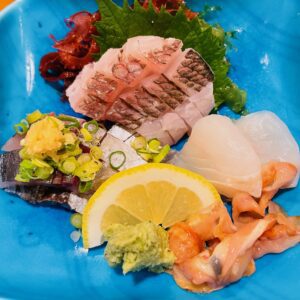
Hatahata (sailfin sandfish) is famous in Akita prefecture, but it can also be caught in Yamagata prefecture, which is located next to Akita prefecture. Yamagata Prefecture has the fifth largest catch of Hatahata (sailfin sandfish) in Japan. As I described in the Aomori / Yamagata trip in December, the fishing season for Hatahata (sailfin sandfish) in Akita prefecture is very short, about one month in December. On the other hand, Hatahata (sailfin sandfish) in Yamagata Prefecture has a long fishing season, and the seasons are June and September to December.
The size of Hatahata (sailfin sandfish) is smaller in Yamagata prefecture and larger in Akita prefecture. This is because Akita Prefecture does not fish until it grows larger. On the other hand, Hatahata (sailfin sandfish) in Yamagata Prefecture fishes before the female’s nutrition is taken up by the eggs, so it is small but has a good taste.

In addition, “Hatahata no Yuage”, which is eaten by adding soy sauce to Hatahata (sailfin sandfish) boiled in a pot, has been selected as “Our Regional Cuisines” by the Ministry of Agriculture, Forestry and Fisheries.
The egg called Buriko was also very delicious with a bubble wrap texture. By the way, the reason why Hatahata’s eggs are called “Buriko” is that when Hatahata was overfished and the fishing was prohibited, they secretly ate it by deceiving them as “Buri’s ko (eggs of Japanese amberjack)”.
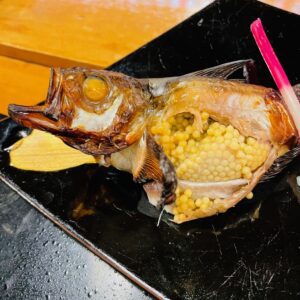
Blowfish is also caught in Yamagata Prefecture, and the quality of blowfish is said to be highly evaluated in the Toyosu market in Tokyo. The blowfish sashimi was refreshing and delicious. In particular, the shirako-yaki of tiger puffer was the best with its sticky texture.

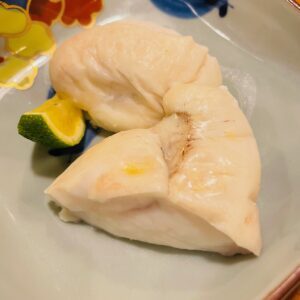
I ate cod milt sashimi at “Izakaya Seigo” the day before, but since it’s the season for cold cod, I ordered it at “Sushi Koise”. Cod milt sashimi is my favorite and it was in season so it was the best.

After enjoying the Tsumami (snacks) and sake, I ordered the sushi “Omakase Nigiri” (Yen 3,300 ), which uses a lot of local fish. Especially, the sushi of Gasa-ebi shrimp (standard Japanese name Kurozako shrimp) from Shonai was sweet and plump and very delicious. The seasonal halfbeak from Shonai was also light and delicious. Everything else was the best sushi and it was a very satisfying dinner.


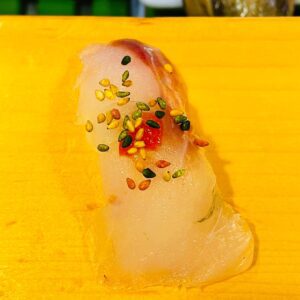





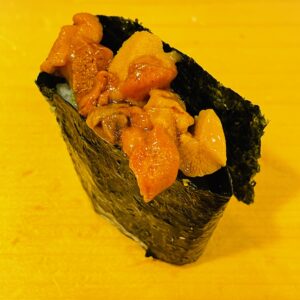
I returned from Sakata station to Tsuruoka station by the following train.
Depart Sakata Station at 19:07, Uetsu Line “bound for Nezugaseki”, arrive at Tsuruoka Station 19:39, fare Yen 510
It was good that the snow was light. The famous song “Yuki no furu machi o (In Snowing Town)” sung by Hideo Ko and others was conceived by composer Yoshinao Nakada when he saw the snow-fall scenery in Tsuruoka. At Tsuruoka Station, the melody of “Yuki no furu machi o (In Snowing Town)” is playing.
Note: The departure / arrival times, fares, admission fees, meal fees, etc. of transportation listed in the text are as of the time of writing the BLOG. Please check for yourself when you go on a trip as it may change in the future.